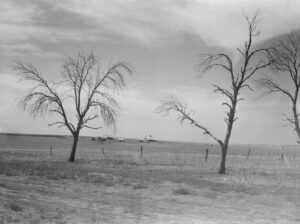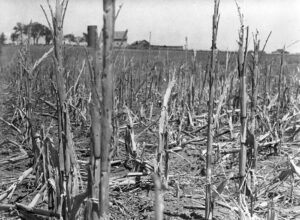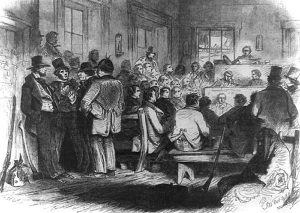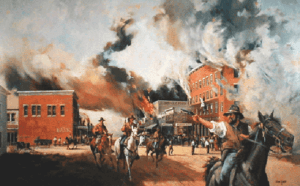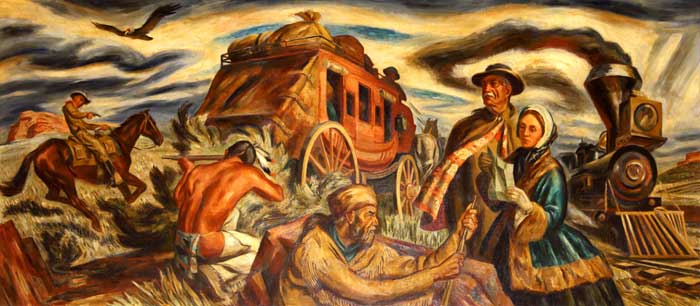
“Pioneers in Kansas,” mural by J. Ward Lockwood.
The seven territorial years had brought freedom to Kansas. However, the struggle left the pioneers little time or strength to build better homes, improve their farms, or establish public institutions. The energy that might have accomplished these things had been given to fighting and politics. When Kansas became a state, the people had almost as few comforts of life as when they first came to the territory. A few had little idea of the hardships and privations of frontier life, and others believed such conditions would last a short time. Many of these, of course, grew discouraged and returned to their eastern homes. But the great body of Kansas pioneers had come with the twofold purpose of securing homes and making a free state, and were not to be discouraged. They had come to stay.
Frontier life was always hard, but the years of strife and warfare made it many times harder in Kansas. The inconveniences and hardships were especially severe outside the towns. In these days of railways and good roads, of the telegraph and the telephone, it isn’t easy to realize what life on the prairies meant in the 1850s. Post offices and mail routes came slowly, and for many of the settlers, a trip for mail and provisions meant a journey of two or three days, or even longer, with an ox team. Neighbors were often many miles apart. Nearly everyone’s supply of farming implements was scanty, and replacing a broken ax might require a trip of 25 to 50 miles. In the winter, these journeys were often accompanied by danger and suffering. Streams were without bridges, and many fords were deep and treacherous. Fences were few, and roads were mere trails over the prairies, so when the blizzard swept across the country, piling its drifts of snow and obliterating every landmark, the unfortunate traveler was in great danger of losing his way. Getting a farm under cultivation was slow work at best. Since most of the settlers brought but little money with them, they had to trust to raise a crop, and if sickness or drought or raids made it impossible to raise the crop, want and suffering followed.
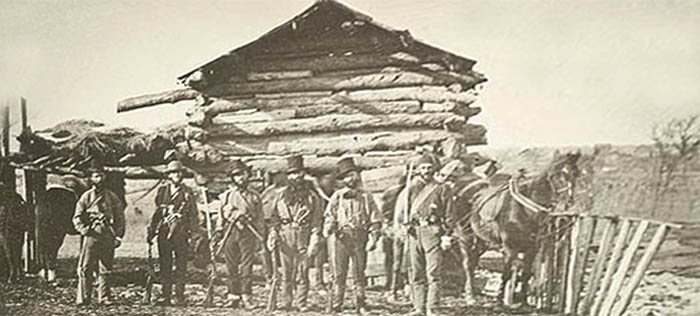
Douglas County, Kansas Pioneers, 1856.
The privations, the sacrifices, and the loneliness of pioneer life fell most heavily on the women. Business and necessity brought the men together occasionally, but the pioneer woman, in the isolation of her prairie home, often saw no friendly face for months at a time. There was much sickness and death, especially among women and children, resulting from poor food, uncomfortable houses, homesickness, and excitement arising from the many dangers. The cost of transportation was so great that only the most necessary articles were brought from the East. Most furniture was homemade, and cooking was done over an open fireplace. Cornbread and bacon with the occasional game and wild fruits were the usual foods. In wet seasons, there were many fevers and illnesses. Sometimes a whole family would be sick at the same time, with no neighbors near enough to help and no physician within many miles.
Each year during the Territorial period, the crops raised were barely sufficient to keep the people through the winter. There was no surplus at any time, and when the summer of 1859 brought a drought, a famine resulted. Through all the brutal struggle, the people believed that prosperity would come as soon as the strife and political difficulties were over. However, with the dawning of peace in the Territory, the most severe drought has occurred in the West. It began in June 1859, and from that time until November 1860, a period of more than 16 months, not enough rain fell at any one time to wet the earth to a depth of more than two inches. Two light snowfalls fell during the winter, but neither was heavy enough to cover the ground. The ground became so dry that it broke open in significant cracks, wells and springs went dry, and the crops failed.
There were nearly 100,000 people in Kansas at this time, and for 60,000 of them, the drought finally meant that they must receive help or starve. They had been able to fight border ruffians, but could not fight starvation. After a year of the drought, they began to give up and go back East. During the fall of 1860, no fewer than 30,000 settlers abandoned their claims and the improvements that had been made at the expense of so much labor and left Kansas. There were still 30,000 people here for whom charity was necessary. All this brought bitter disappointment to the people who had come to Kansas with high hopes and willing hands.
As soon as the actual condition of affairs was known in the East, a movement began to relieve the sufferers. Many states responded liberally, and immense quantities of provisions and clothes were sent here to be distributed. Hundreds of bushels of seed wheat were furnished. Besides the public help, many relatives and friends sent supplies to the pioneers. Nevertheless, there were many that winter who barely escaped starvation.
As great as the suffering from disappointment and want was, the drought brought another evil: it threw Kansas back in its development. Not only had a third of the population left the Territory, but the accounts given by those who turned tended to discourage others from coming. The old stories about the “Great American Desert” were revived. Kansas was looked upon as a place of drought and famine, and the number of immigrants decreased significantly over several years.
All this was taking place while the Wyandotte Constitution was being considered. Kansas was admitted as a State on January 29, 1861, at the close of the terrible drought. Through the winter and spring of 1861, supplies continued coming in from other states, including seeds for spring planting. An excellent season followed. It might be thought that the Kansas settlers were to have an opportunity to cultivate their farms, build homes, and make their new State a place of peace and prosperity. But not so; Kansas was again to suffer from the troubles of the Nation. The opening of the Civil War was near.
The fighting and political strife of the Territorial period left the people little opportunity to build up the country. Statehood found frontier life, but little improvement. The early settlers came to secure homes and make Kansas a free state, and they were not easily discouraged. The drought of 1859-1860 caused nearly a third of the 100,000 Kansas settlers to leave the Territory, and another third had to be given aid from the East. Immigration to Kansas significantly decreased for a time. A good crop year followed, but Kansas had yet to pass through the Civil War before it could enjoy peace.
Compiled & edited by Kathy Alexander/Legends of America, updated May 2025.
Also See:
Source: Arnold, Anna E.; The State of Kansas; Imri Zumwalt, state printer, Topeka, Kansas, 1919.

